

A Report on Industrial Visit of Composite Textile Mill
Last Updated on 22/05/2022
A Report on Composite Textile Mill Visit
Naha N Hasan B.Sc. in Wet Processing Noakhali Textile Engineering College
Dragon Sweater (BD) Ltd. Mia Bazar, Chouddogram, Comilla
Introduction: Industrial textile mill visit is one the important element of professional education especially for textile engineering education. By mill visit students can learn about textile factories and mills, the production cycle, and the roles of textile workers.

Organogram of Composite Textile Mill:
Administration
Floor In-charge
Flow Chart of Production Process:
Light Check
Winding Section: Following types of yarns are processed here
- 100% Acrylic
- 100% Cotton
- Nylon Cotton
- Feather yarn/ Sheenal
- Highly loop
- Different melange
These types of yarns are identified hand feeling and visual appearance. Here dyed yarns in skein form are wound on cone of 3/4 lbs. The rpm of the motor of winding m/e is 1400. 8 cones can be wind at a time. The dia of hexagonal frame is 29”. Here non precession winding is done by the surface contact rotation of grooved roller. Sometimes 2 or more plies of yarn wind in the same cone. The drive mechanism of this machine is rotary cylinder drive.
Knitting Section: Following parts of sweater are prepared in the flat bed knitting machine on the fashioning technology.
- Lace, Rope etc.
Here following gauge are available and following yarns are feed:
3GG→5/6 Ply 5GG→3/4 7GG→2 12GG→1
Latch needle are used here.
Different Parts of the Knitting Machine:
- Gear handle (body gear)
- Stand brush
- Yarn controller
- Side weight
- Weight stand
After preparing the yarns are attached to represent the different parts.
Green→S Red→M Yellow→L Black→XL White→XXL
Following designs are produced:
- Single jersey→ on the body, sleeve
- Rib 1×1 2×1 2×2 etc.→ Wrist, cuff, body, sleeve, neck
- Segger→ body, front part, bottom part
- Pine apple→ on the front part
- Cable→ on the front part
- Purl → lace, body
- Color stripe
And many of the designs as to the buyer choices.
Linking Section: Here different separate parts of the sweater are joined together. Acrylics, Cotton, Melange yarn are used. 3GGG, 5GG, 7GG, and 12GG machines are available here. The motor of linking machine is 1420 rpm, 50Hz, ½ HP, 110/220V. Sometimes to produce design on the body stitching is done by linking machine.
Stitch type→ 101 4 over 1 overlocking machine are used to protect the seam at shoulder, neck.
Stitch type→ 406 Seam class 1→Arm hole, body joining Seam class 4→Neck, collar joining Seam class 2→Lace, Zipper joining
Continue Section: While producing of color stripe or finishing of knitted parts there remain extended yarn. In this section these types of uncut yarns are removed manually by cutter. The extended portions of the stitch are joined on the fabric by needle manually.
Light Check: There are hole on prepared sweater parts due to needle miss or hung weight or during narrowing. To find out different faults light checking is done by wearing sweater parts on dummy shape. Then faults are identified and marked by yarn by knotting.
Mending Section: The holes on the sweater are filled here manually by the latch needle. Cotton or acrylic yarns are used to carry out this operation.
Sewing Section: Here versatile tasks are done by the following machines.
Single needle lock stitch machine: In this machine attachment of fastening device zipper, size level, care level are done.
Stitch type 301 Bar taking machine: Frequent no of stitches are sewn on certain place for reinforcements. Usually it’s done on the bottom of the body and armhole joining. Stitch type 103
Button holing machine: Button holing is done by this machine on the sweater. Again the side of button hole is sewn here.
Button attaching machine: By this automatic machine button is attached on the specific place. Generally 2/4 hole button is used. Stitch type is 104
4 over 1 overlocking machine: Such machines are used to protect the seam at shoulder, neck. Stitch type 406
All this machines are of Jucky Company. 2 ply Cotton, polyester yarn are used here.
Washing Section: The aim of this section is to remove the ambient dirt, dust, oil spots during processing and also to soften the sweater. Usually this process is done by applying
- Surf excel→250gm
- Jet detergent→250gm
Time and Temperature
- 100% Acrylic→60 C 25 min
- 100% Cotton→70 C 25 min
- Mixed Fibre→70 C 20 min
There temp is raised by steam. After washing, rinsing is carried out for 2 3 mins. In the case of softening 500gm Softex are applied. To remove the hardness of the water oxalic acid are used. Otherwise it create iron mark on light or white colored goods. After washing to squeeze excess water the wet sweater are run on hydro extractor for 5 6 mins.
At last drying is done on dryer.
- 100% Acrylic→25 min
- 100% Cotton→45 min
- Mixed Fibre→30 min
Ironing: It’s just to recover shrinkage , size and to have good dimensional stability. Steam of 120 C is applied on the different place of the sweater placing ply card of specific size on it. It’s applied for 2 3 mins from the 2.5 inch above by the iron. Ply card are prepared according to the different of sizes that supplied by buyer.
Pre QC-1 and Pre QC-2: Here two steps of quality checks are done before final check. Uncut threads are removed, mending is done if required. Here clearing gun is used to remove oil or light spot. Hence volatile solvent named air brush water is sprayed. Its application is below 5 mins to avoid harmful effects.
QC Check: Here following measurement are rechecked besides the checking of seam joining/ strength.
- Active chest
- Body length
- Sleeve length
- CB to Sleeve length
- Neck height
- Back Neck drop
- Wrist height
- Cuff height
General Tasks:
- Removal of uncut thread of the sewing section
- Mending on hole
- Zippers on accurate line
- Different spots
- Accurate weight Button, levels are on accurate place
- Dissimilarity on shade on sweater
Packing: After super check the sweater are folded. Hangtag is attached and packed on polybag. Usually hangtag, ball pin, polybag etc are supplied by buyer.
Cartooning: It’s done manually. Cartoons are supplied by buyer which contains a lot of information. Sizes of the cartoon are 810mm×470mm×260mm or so on. The blaster of sweater is of 12 pieces and so on maintaining following.
- XS→2 pieces
Net weight 10kg Gross weight 11.kg so on Blasters are prepared according to size ratio, color or buyer choice.
Other Section:
Dyeing Section: w/v gm in 100 ml of water v/v cc in (100-cc) rest of water The stock sol n are prepared by the applying the following formula. For the %, the formula can be written as,
Required CC = (w x p)/c ml
Where as, W = wt of the sample P = shade % C = stock soln %
Again for the g/l, the formula can be written as,
Where as, W = total liquor (lit) = (wt of sample x L)/ 1000 ml P = recipe amount in g/l C = stock sol n %
Again for the bulk production the formula can be written as, Required reagent = (material weight x recipe amount %) Required reagent = (total liquor liter x recipe amount g/l)
Here, Sample weight is → 5gm Dyestuff stock sol n → 0.1% (.5gm on 500ml, 1gm on 1000ml) Chemical stock sol n → 1.0% Dyeing is carried out → 9 C × 20˜25 min (atm pressure) M:L→1:40 (200ml)
Addition or subtraction of color is done by%. In the cases of re-dyeing additional % is counted.
Generally primary colors that are used
- Yellow 4GNT (light)
- Golden Yellow BRT (deep)
But for the Black
Chemicals T-PAN Leveling Agent [(Σall syestuff-1.8) %] AN Auxiliary To maintain PH→4, 10CC CH 3 COOH are added on 25 liter of H 2 O.
100% Cotton (white) After scouring properly BF 70→ 0.5gm/l White BYB→ 0. 8%
Color out NaHSO4→ 5gm/l NaCO3→ 2gm/l
Cold wash 01 NaOH → 0.5gm/l or NaCO3→ 1gm/l H2O2→ 2gm/l BF 70→ 1gm/l
Cold wash 02 HAC→ 4% H/S→ 4%
100% Cotton Soaping (98oC x 10 min) BF 70→ 1.0gm/l PLG 1500→ 0.5gm/l EA 20/10→ 0.5gm/l NaOH→ 1.5gm/l H2O2→ 2.5gm/l
Cold wash 01 HAC→ 0.5gm/l (30 o C x 10 min)
Hot wash H/S 10→ 1.5gm/l 90 o C x 20 min)
Cold wash 02 HAC→ 0.5gm/l (30 o C x 10 min) 100% Cotton Dyeing at 40 o C ˜ 60 o C
Steeping NaOH→ 0.5gm/l or NaCO 3 → 1gm/l (98 o C x 50 min)

Founder & Editor of Textile Learner. He is a Textile Consultant, Blogger & Entrepreneur. He is working as a textile consultant in several local and international companies. He is also a contributor of Wikipedia.
Share this Article!
Related Posts:

Leave a Comment Cancel reply
Save my name, email, and website in this browser for the next time I comment.
Notify me of follow-up comments by email.
Notify me of new posts by email.

- Real Estate
Home » Report Templates » Free Industry Visit Report Templates (Excel / Word / PDF)
Report Templates
Free industry visit report templates (excel / word / pdf).
When an individual visits the industry whether he or she is a student or an employee, they need an industry visit report template to create a visit report. This document contains a detailed summary of the visit organized in a sequence.
Table of Contents
How to write an industry visit report?
Here are the steps to write an industry visit report;
Introduction
In this section, provide the introductory information about the event including;
- Who proposed and organized it
- Complete designation of the facility you’ve visited
- The name of your college or company
- The names and positions of people who played a significant role in organizing and implementing the event
- Faculty members who are associated with the students or employees
- Total number of people involved in it
Details of Visit
Here, you need to provide the following details about the visit;
- The timeline of the visit
- Point-by-point detail of every part of your journey
- Where and when you started
- What industries and facilities you’ve visited
- Where and when you attended seminars
- When the event ended
- When you come back
Detailed descriptions
Describe the important stages of your visit in detail. In case, you have attended seminars then specify the following;
- When and where they took place
- How long they lasted
- Who conducted them
- What they were about
- What you’ve learned
- Your general impressions
In addition, if you have visited any specific places then mention the locations, staff members that are with you during the visit, knowledge you got during the visit, and your feedback about the visit.
Travel details
This part of your report includes technical and statistical details;
- Names of the people or students who are with you during the visit
- The place where you stayed
Feedback from students or employees
In the end, the students or employees have to provide their generalized opinion of the whole event. State whether it was useful and whether you got any specific new knowledge and experiences from it.
Store Visit Report Form
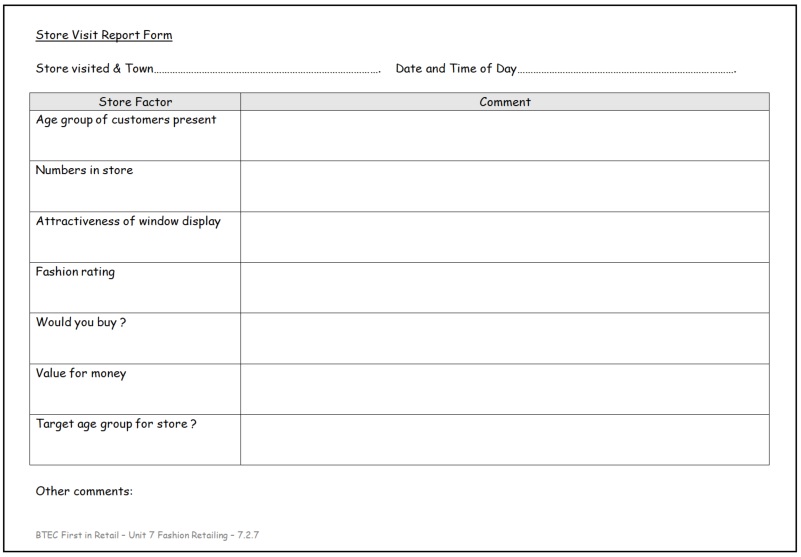
School Visit Report Form

Site Visit Report Sample
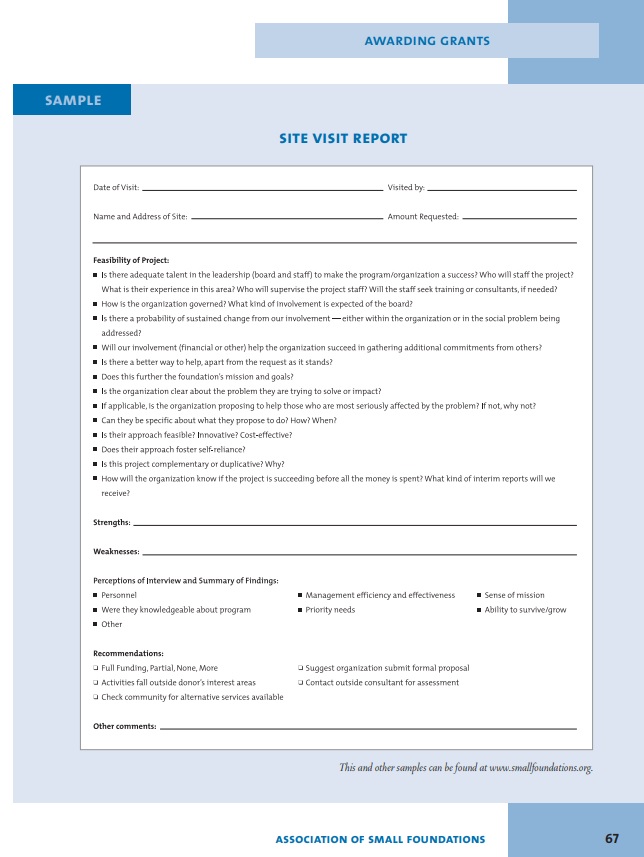
Industry Visit Report Template
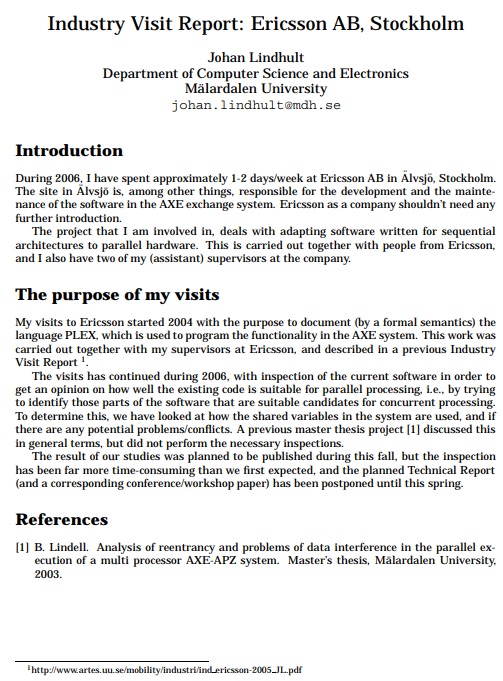
Team Home Visit Report Template
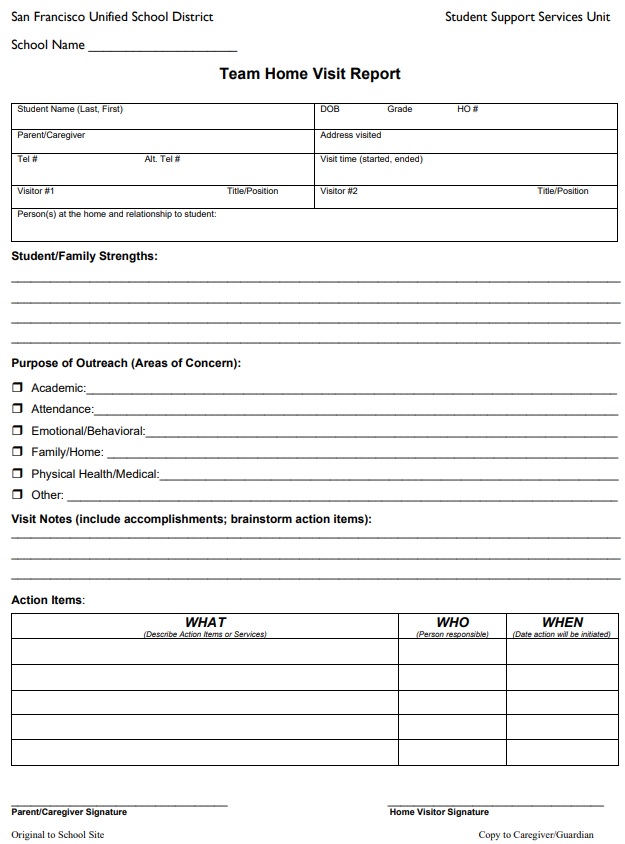
Field Visit Report Template
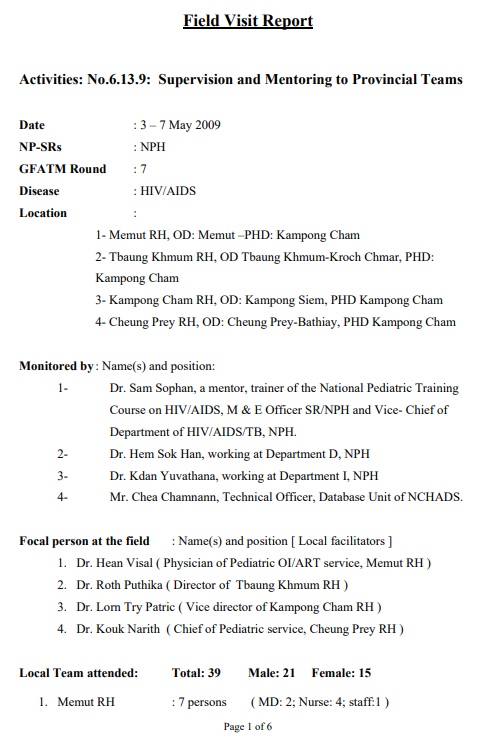
Sales Person Daily Progress Report Template

Construction Site Visit Report Template
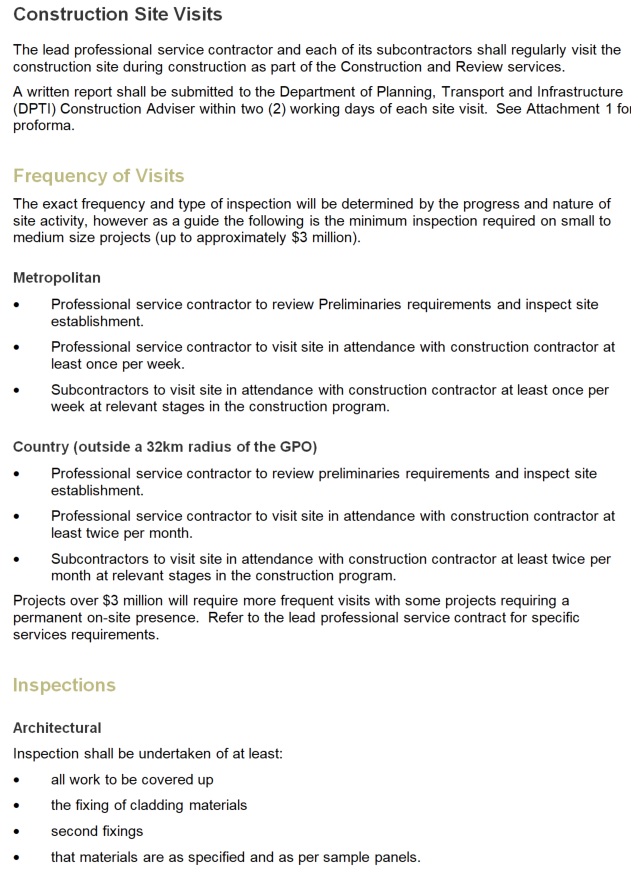
Business Visit Report Template

It provides you with updated details regarding the current events after a visit. It facilitates decision-making in a company.
First, state the general information about the visit and specify the purpose of the visit. Describe the entire visit in detail and summarize the report with important information.
You May also Like

Sharing is caring!
I am Ryan Duffy and legal writer. I received a bachelor of business administration (BBA) degree from London Business School. I have 8+ years of writing experience in the different template fields and working with ExcelTMP.com for 7 years. I work with a team of writers and business and legal professionals to provide you with the best templates.

Industrial Visit Report on Tisser India Pvt. Ltd.
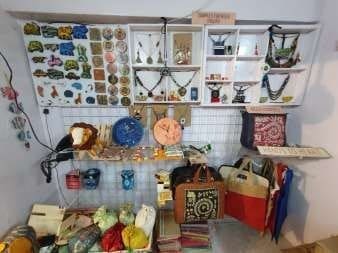
Report objective: To visit textile industry and gather information about production process and working of the industry.

Fig 1. At Tisser India with Fatima Nalwala ( Sales Superviser)
Tisser Artisan Trust is a social enterprise that works to improve the lives of people in India’s rural areas. Women in rural clusters are being retrained and given career possibilities, restoring the dignity of labour. The chances generated are aimed at restoring handcraft goods inspired by India’s rich cultural past, with each art group throughout the globe having its own distinct offering. Women and art are being promoted in great steps of empowerment and exposure. The Tisser Artisan Trust is funded by the income from various grants and the commissions from initiatives we carry out in the interest of providing livelihood for artisans and reviving art. In order to keep artisans in rural clusters afloat, they are taught to manufacture things that are in high demand. It also includes quality assurance and reproduction. They will be able to work independently in the future thanks to the training and direction of cluster managers. Such financial and moral assistance aids people in escaping loan and debt traps. Tisser Artisan Trust actively promotes women’s empowerment by connecting them to larger, more inclusive value chains. The TAT team documents the lives and efforts of such empowered women.
Madhubani, Warli, Kalamkari, Ikat, Teracotta, Pattachitra, Tussar Silk, Block Print, Chanderi, Maheshwari, Dokra, and a variety of other tribal art forms are among the art forms they pursue. Campaigns like “Har Ghar Mein India,” the Grassroot Artisan Movement, and cluster development collaborations with UNDP, L&T, Pidilite, and the Maharashtra State Innovation Society helped them grow the plurality.
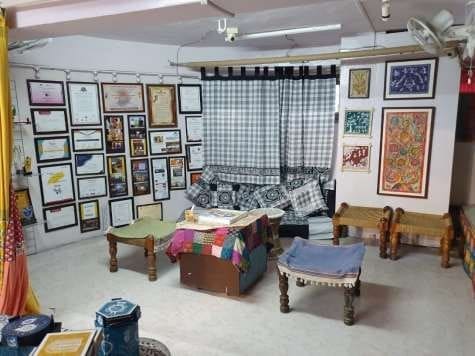
Fig 2. Tisser India display room
It documents the diverse stories of women and their strength, creates quality checks to maintain uniformity, builds financial infrastructures to prevent women from falling into debt traps, builds artisan clusters from a tourism perspective to open opportunities for our artisans, and helps artisans at each stage so that they can function independently, all with the goal of sustaining the community. In terms of community development, it aims to provide better opportunities for women who do not have access to education and inclusion, intervene in the value chain with small producers to encourage participation in mainstream markets, and train them in design and function to meet the market’s growing and changing demands.
They have won several awards and recognition such as Priyadarshini Award for outstanding Women Entrepreneurs, Impact award at NAFW, Seattle 2019, Rani Laxmi Bai Bhushan Puraskar, Times She UnLTD. Entrepreneur Awards 2019, Nari Shakti Awards 2018 – Business and Enterprenuership, Iprenuer – National finalist and many others.
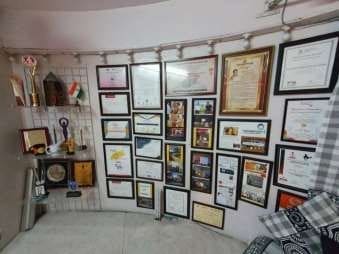
Fig 3. Tisser India hall of fame
Tisser brand has been developed with a sense of duty in order for the loom and craft industry to remain not only a bulwark of our historical inheritance, but also to turn into an enterprising fortune of craftsmen in addition to current trade and future commerce. Tisser products are organic, handcrafted, modern, and inexpensive.
They offer wide range of handicraft products such as coasters, jewelry, books, etc

Fig 4. Tisser India handicraft products
They also have amazing collection of Apparel products for both men and women wear. These products are made by the clusters and sold across countries. These products have traditional touch of Indian art. The ir art include hand block print, tussar silk weaving, etc
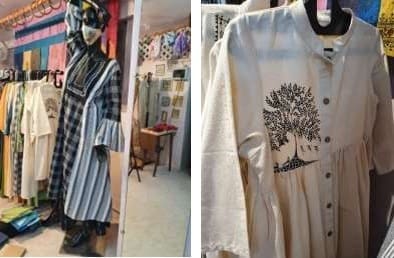
Fig 5. Tisser India Apparel products
The firm has inhouse team of packaging and production department which are very keen and skilled in their work.
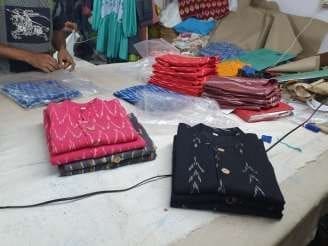
Fig 6. Tisser India manufacturing department
Report Summary
This visit was one of its kind to get practical exposure and deep understanding about Tisser India textiles and handicraft. Women in rural clusters are being retrained and given career possibilities, restoring the dignity of labour. Tisser Artisan Trust actively promotes women’s empowerment by connecting them to larger, more inclusive value chains. The TAT team documents the lives and efforts of such empowered women. It documents the diverse stories of women and their strength, creates quality checks to maintain uniformity, builds financial infrastructures to prevent women from falling into debt traps, builds artisan clusters from a tourism perspective to open opportunities for our artisans, and helps artisans at each stage so that they can function independently, all with the goal of sustaining the community.
In terms of community development, it aims to provide better opportunities for women who do not have access to education and inclusion, intervene in the value chain with small producers to encourage participation in mainstream markets, and train them in design and function to meet the market’s growing and changing demands. They have inhouse team of designers, web developer, graphic designer, tailors who collectively bring the community together by sharing and uplifting the art form of India through their products. This venture is one of its kind as its concept design, products and presentation skills sets it apart from others.
- https://tisserindia.com/
- https://tisser.in/
- https://www.instagram.com/tisserindia/?hl=en
By Ayman Satopay
Related Posts
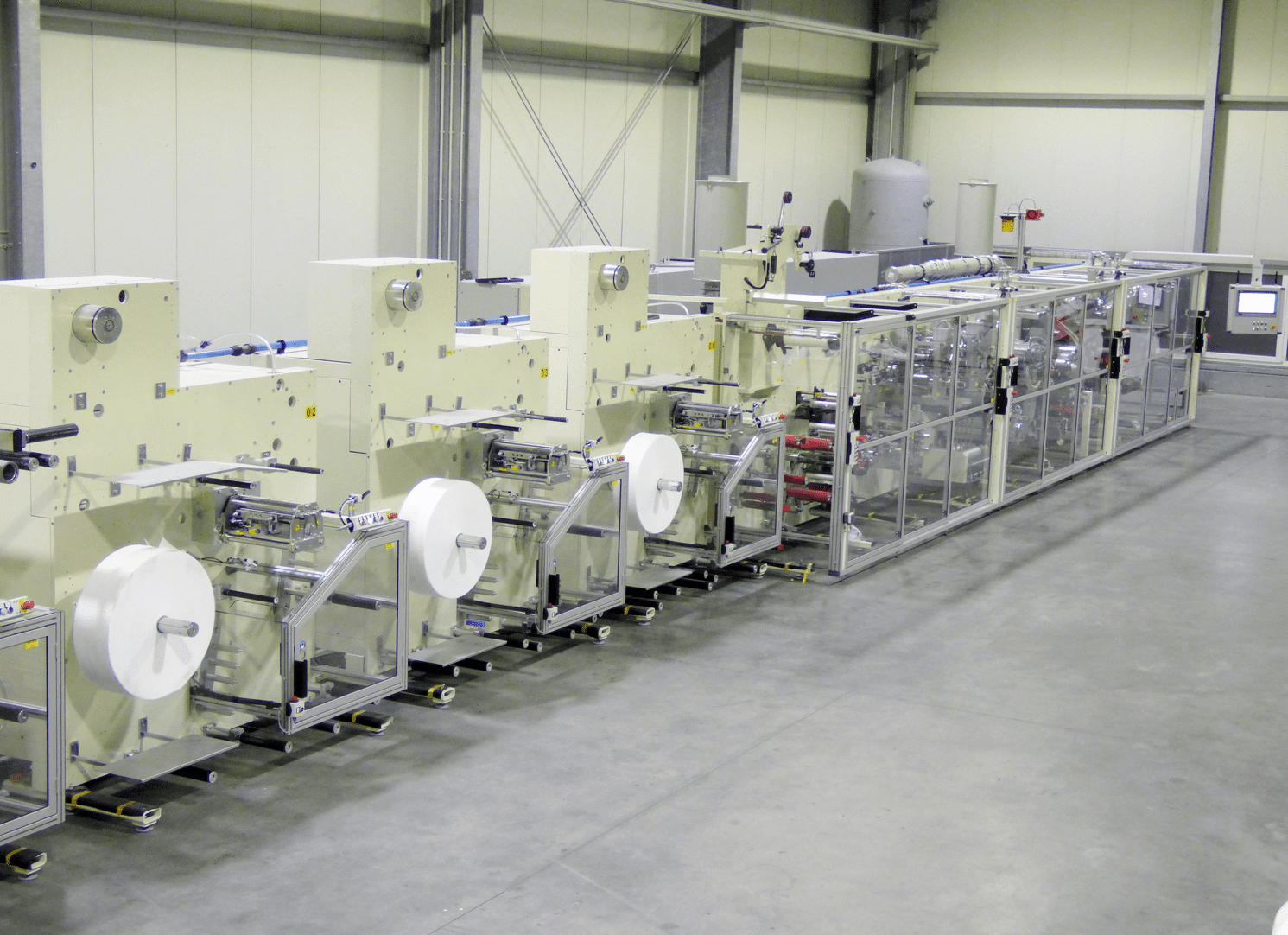
A.T.E. partners with W+D BICMA, Germany, to bring textile hygiene manufacturing technologies to India.


L&T completes several plant shutdowns at HPCL’s Mumbai refinery at the same time

WHY ACCESSORIZING IS NECESSARY SOLUTIONS TH WAY OF LIFE & TREND INFLUENCER SONIA PRONK

Vipul Organics receives the 1st award from CHEMIXCIL for Dyes and Dye Intermediates Panel
Textile Industry Size & Share Analysis - Growth Trends & Forecasts (2024 - 2029)
The Report Covers Global Textile Market Trends & Statistics and it is Segmented by Application Type (Clothing Application, Industrial/Technical Application, and Household Application), By Material (Cotton, Jute, Silk, Synthetics, and Wool), By Process (Woven and Non-woven), and By Geography (North America, Europe, Asia-Pacific, Latin America, and the Middle East and Africa). The report offers market size and forecasts for the textile industry in Value (USD billion) for all the above segments.
- Textile Market Size
Single User License
Team License
Corporate License
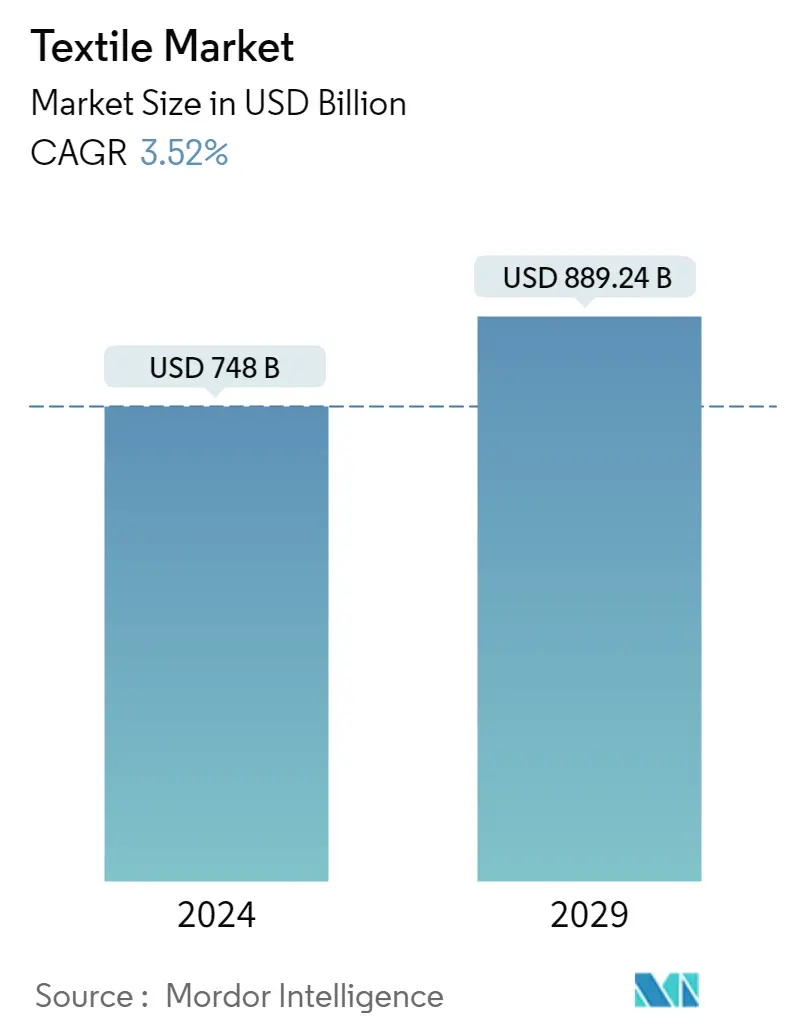
Need a report that reflects how COVID-19 has impacted this market and its growth?
Textile Market Analysis
The Textile Market size is estimated at USD 748 billion in 2024, and is expected to reach USD 889.24 billion by 2029, growing at a CAGR of 3.52% during the forecast period (2024-2029).
The COVID-19 pandemic has challenged the textile industry drastically in 2020. Asia, which is one of the largest markets for the textile industry in the world, has suffered from the prolonged lockdowns and restrictions in the majority of Asian countries along with the sudden drop in international demand for their products. The loss was particularly high in countries where the textile industry accounted for a larger share of the exports. According to the study by the International Labour Organization (ILO) the global textile trade collapsed during the first half of 2020. Also, exports to the major buying regions in the European Union, the United States, and Japan fell by around 70%. The industry also suffered several supply chain disruptions due to the shortages of cotton and other raw materials.
The textile industry is an ever-growing market, with key competitors being China, the European Union, the United States, and India. China is the world's leading producer and exporter of both raw textiles and garments. The United States is the leading producer and exporter of raw cotton, while also being the top importer of raw textiles and garments. The textile industry of the European Union comprises Germany, Spain, France, Italy, and Portugal at the forefront with a value of more than 1/5th of the global textile industry. India is the third-largest textile manufacturing industry and is responsible for more than 6% of the total textile production, globally. The rapid industrialization in the developed and developing countries and the evolving technology are helping the textile industry to have modern installations which are capable of high-efficient fabric production. These factors are helping the textile industry to record more revenues during the study period and are expected to help the industry further in the forecast period.
- Textile Market Trends
This section covers the major market trends shaping the Textile Market according to our research experts:
Increasing Demand for Natural Fibers
Natural fiber composites are relatively lighter and have more strength than conventional fibers, and therefore, find extensive application in the automotive industry for interior and exterior applications. Natural fibers obtained from plants and animals include cotton, silk, linen, wool, hemp, jute, and cashmere. These fibers are widely used to manufacture garments, apparel, construction materials, medical dressings, and interiors of automobiles, among others. The abundance of natural fibers, especially cotton, in China, India, and the United States, is contributing significantly to the growth of the global textile market. Silk is used in upholstery and apparel, as it is available in both variations fine as well as coarse. Wool and jute are used as textile materials for their resilience, elasticity, and softness. The increasing consumption of natural fibers, such as cotton, silk, wool, and jute, will drive the global textile market during the forecast period.
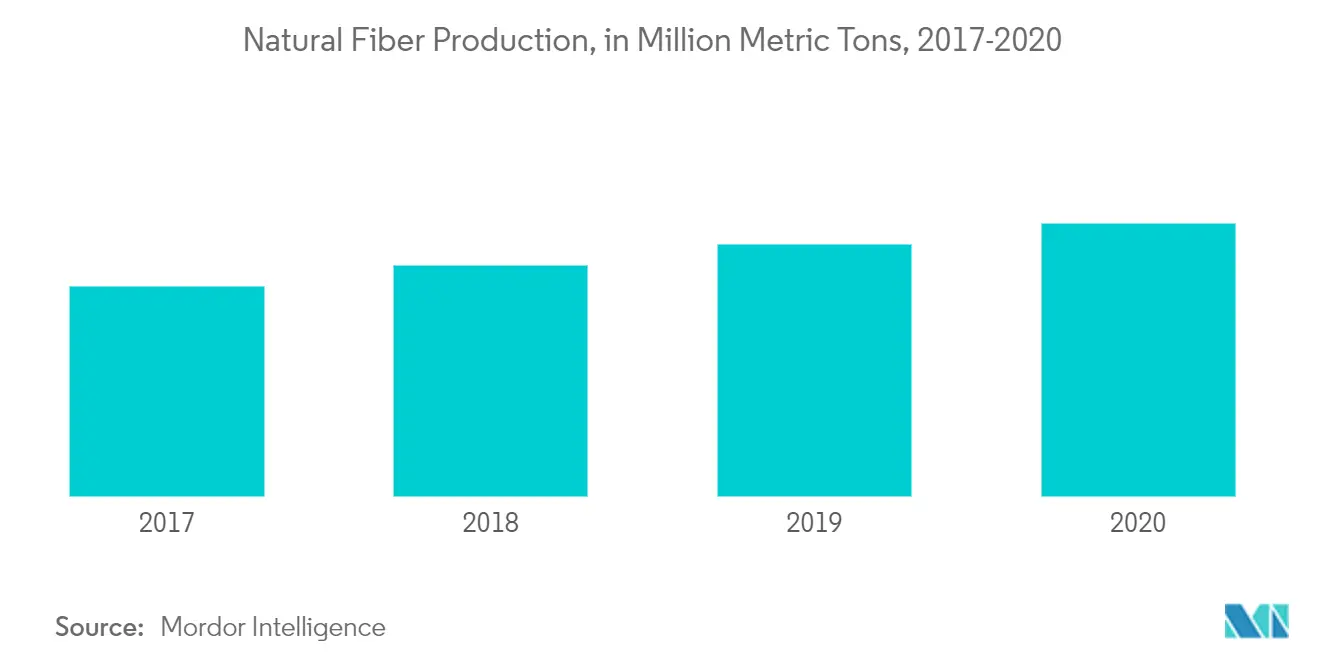
Shifting Focus Toward Non-woven Fabrics
The increasing birth rate and aging population has contributed to the growing demand for hygiene products, such as baby diapers, sanitary napkins, and adult incontinence products, which, in turn, is expected to fuel the demand for non-woven fabrics. Nonwovens are used in road construction in the form of geotextiles to increase the durability of roads. Low maintenance costs associated with nonwovens are expected to fuel its demand in construction applications. The positive outlook of the automobile and transportation industry, globally, is further expected to propel growth for the non-woven fabric market over the next years. The automobile industry manufactures a large number of exterior and interior parts using non-woven fabrics owing to their durability. Rapid industrialization and recent innovations in the field of textile technology are other factors fueling demand for non-woven fabrics, globally.
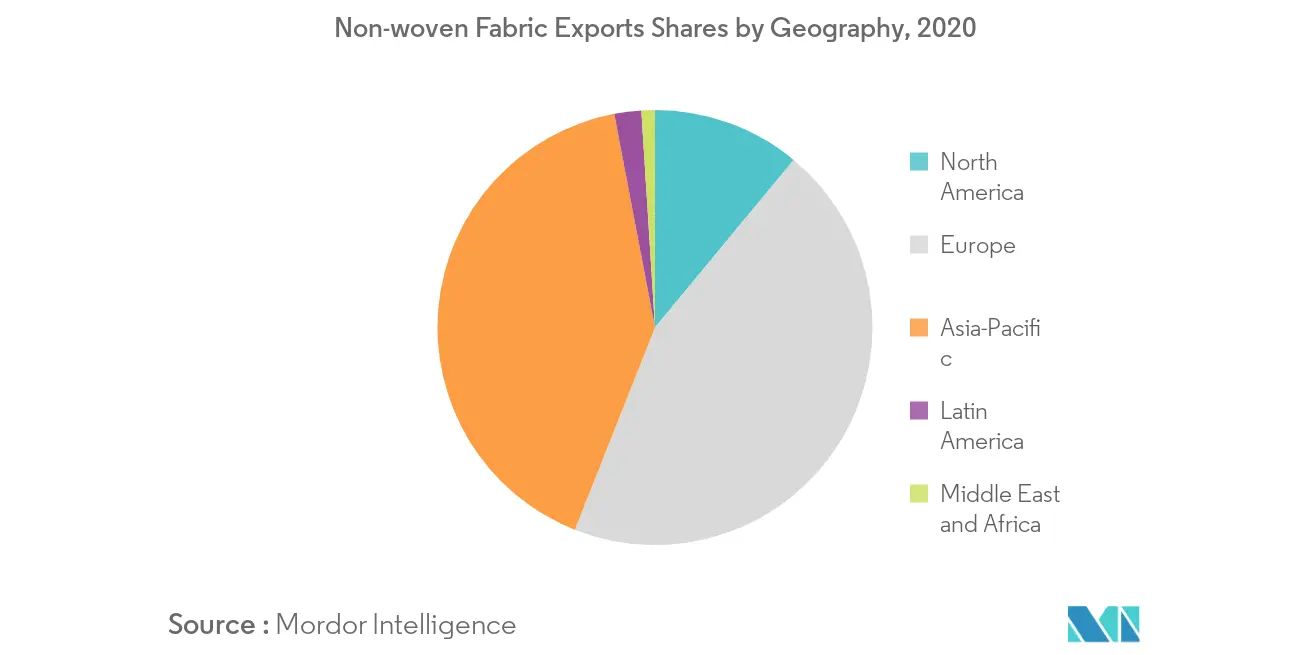
Textile Industry Overview
The report covers the major players operating in the textile industry. In terms of market share, the companies in the global textile industry do not have a considerable amount of market share, as the market is highly competitive and fragmented.
Textile Market Leaders
Toray Industries Inc.
B.C. Corporation
Shandong Weiqiao Pioneering Group Company Limited
Nisshinbo Holdings Inc.
*Disclaimer: Major Players sorted in no particular order
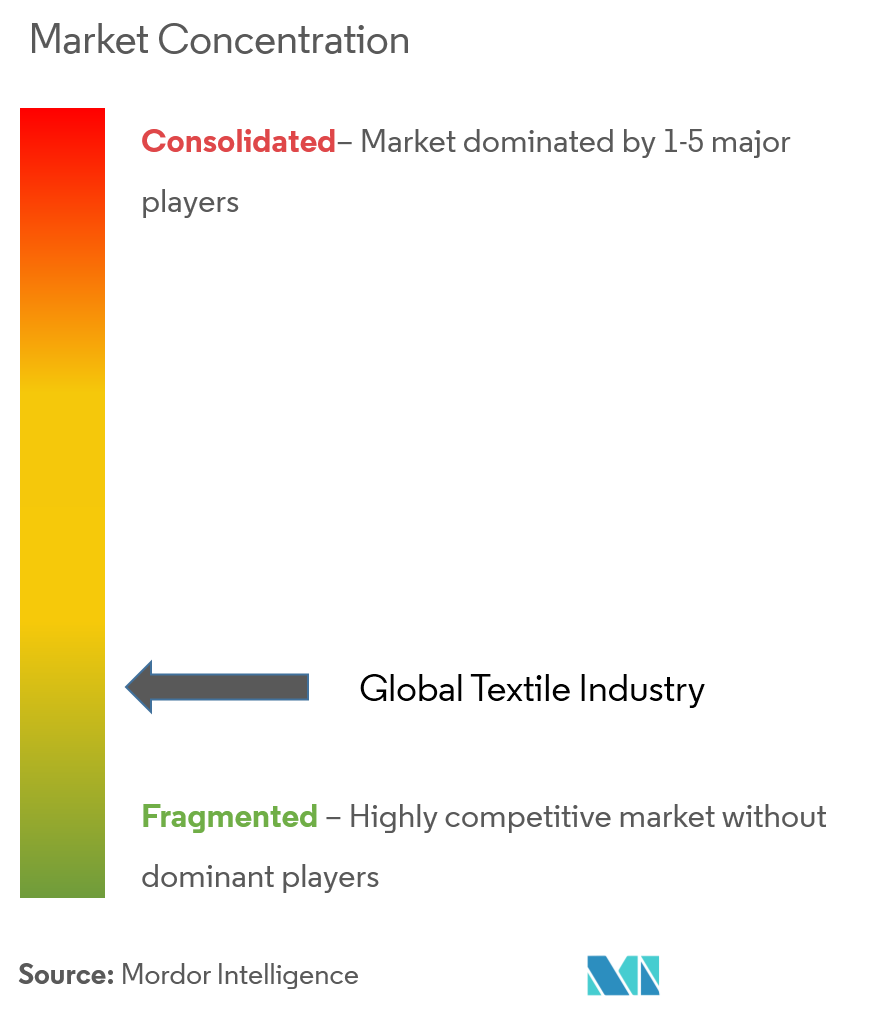
Textile Market News
- In Feb 2021, The Indian Government has announced the setting up of seven mega textile parks in the next three years. The government has also decided to rationalize the duties on raw material inputs to manmade textiles by reducing the customs duty rate on caprolactam, nylon chips, and nylon fiber and yarn to 5 %.
- In Feb 2021, Paraguay's Ministry of Industry and Commerce announced that it will be investing USD 1.1 million in the manufacturing sector, mainly benefiting the clothing, textiles, and footwear industries, among other areas related to assembly operations.
Textile Market Report - Table of Contents
1. INTRODUCTION
1.1 Study Assumptions and Market Definition
1.2 Scope of the Study
2. RESEARCH METHODOLOGY
3. EXECUTIVE SUMMARY
4. MARKET INSIGHTS AND DYNAMICS
4.1 Market Overview
4.2 Market Drivers
4.3 Market Restraints/Challenges
4.4 Market Opportunities
4.5 Value Chain / Supply Chain Analysis
4.6 Industry Attractiveness - Porter's Five Forces Analysis
4.7 Technological Innovation in the Industry
4.8 Impact of COVID-19 on the Textile Industry
5. MARKET SEGMENTATION
5.1 Application
5.1.1 Clothing Application
5.1.2 Industrial/Technical Application
5.1.3 Household Application
5.2 Material
5.2.1 Cotton
5.2.4 Synthetics
5.3 Process
5.3.1 Woven
5.3.2 Non-woven
5.4 Geography
5.4.1 North America
5.4.2 Europe
5.4.3 Asia-Pacific
5.4.4 Latin America
5.4.5 Middle East & Africa
6. COMPETITIVE LANDSCAPE
6.1 Market Competition Overview
6.2 Company Profiles
6.2.1 Toray Industries Inc.
6.2.2 B.C. Corporation
6.2.3 Industria de Diseno Textil SA (Inditex SA)
6.2.4 Shandong Weiqiao Pioneering Group Company Limited
6.2.5 Nisshinbo Holdings Inc.
6.2.6 Chori Co. Ltd
6.2.7 Texhong Textile Group Ltd.
6.2.8 Aditya Birla Nuvo Ltd
6.2.9 Hyosung TNC Corp.
6.2.10 PVH Corp.
6.2.11 Far Eastern New Century Corp
6.2.12 Arvind Ltd*
- *List Not Exhaustive
7. FUTURE OF THE MARKET
8. DISCLAIMER
Textile Industry Segmentation
The report aims to provide a detailed analysis of the global textile industry. It focuses on market dynamics, technological trends, and insights on the geographical segments and the process, material, and application types. Also, it analyses the major players and the competitive landscape in the global textile industry. The Textile Industry is Segmented by Application Type (Clothing, Industrial/Technical Applications, and Household Applications), By Material (Cotton, Jute, Silk, Synthetics, and Wool), by Process ( Woven and Non-woven), and by Geography (North America, Europe, Asia-Pacific, Latin America, and the Middle East and Africa). The report offers market size and forecasts for the textile industry in Value (USD billion) for all the above segments.
Textile Market Research FAQs
How big is the textile market.
The Textile Market size is expected to reach USD 748.00 billion in 2024 and grow at a CAGR of 3.52% to reach USD 889.24 billion by 2029.
What is the current Textile Market size?
In 2024, the Textile Market size is expected to reach USD 748.00 billion.
Who are the key players in Textile Market?
Toray Industries Inc., B.C. Corporation, Inditex SA, Shandong Weiqiao Pioneering Group Company Limited and Nisshinbo Holdings Inc. are the major companies operating in the Textile Market.
Which is the fastest growing region in Textile Market?
North America is estimated to grow at the highest CAGR over the forecast period (2024-2029).
Which region has the biggest share in Textile Market?
In 2024, the Asia Pacific accounts for the largest market share in Textile Market.
What years does this Textile Market cover, and what was the market size in 2023?
In 2023, the Textile Market size was estimated at USD 722.57 billion. The report covers the Textile Market historical market size for years: 2019, 2020, 2021, 2022 and 2023. The report also forecasts the Textile Market size for years: 2024, 2025, 2026, 2027, 2028 and 2029.
Which segment of the Textile Market is expected to grow at the fastest rate?
The technical segment of the Textile Market is expected to grow at the fastest rate.
What are the major factors driving the growth of the Textile Market?
The major factors driving the growth of the Textile Market are a) The ever-increasing demand for apparel from the fashion industry b) Rising demand for textiles in various applications including household, technical, and fashion c) Growing consumer preference for sustainable products and Increasing use of smart textiles
Our Best Selling Reports
- 3D Sensor Market
- Business Process Outsourcing Market
- Force Sensors Market
- High Speed Cameras Market
- Industrial Air Compressor Market
- Netherlands E-commerce Market
- Newspaper Market
- Synchronous Motor Market
- US e-commerce Market
- Waste Management Market
Textile Industry Report
The global textile market is experiencing significant growth, driven by the increasing demand for apparel influenced by the fashion industry and the expansion of e-commerce platforms. Segmented based on raw materials like cotton, wool, silk, and chemicals, with cotton leading due to its superior properties, the market features product segments including natural fibers and synthetic materials such as polyester and nylon. These are chosen for specific applications due to their unique properties. The application of textiles spans across fashion, household, and technical sectors, with fashion being a dominant segment due to high consumer spending and the influence of social media. Additionally, the market is witnessing a shift towards sustainable products, with companies investing in eco-friendly manufacturing processes. The use of smart textiles is also on the rise, incorporating materials that respond to environmental stimuli, expected to boost the technical textiles segment. This textile industry report provides an in-depth analysis, including key statistics, to offer a comprehensive overview of the market trends and dynamics. For detailed statistics on the textile market share, size, and revenue growth rate, access Mordor Intelligence™ Industry Reports, which include a market forecast outlook and historical overview. Get a sample of this industry analysis as a free report PDF download.
Textile Market Report Snapshots
- Textile Market Share
- Textile Companies
Please enter a valid email id!
Please enter a valid message!

Textile Market Get a free sample of this report
Please enter your name
Business Email
Please enter a valid email
Please enter your phone number
Business Email *
Company Name *
Please enter a company name
Get this Data in a Free Sample of the Textile Market Report
Please enter your requirement

Thank you for choosing us for your research needs! A confirmation has been sent to your email. Rest assured, your report will be delivered to your inbox within the next 72 hours. A member of our dedicated Client Success Team will proactively reach out to guide and assist you. We appreciate your trust and are committed to delivering precise and valuable research insights.
Please be sure to check your spam folder too.
Sorry! Payment Failed. Please check with your bank for further details.
Add Citation APA MLA Chicago
➜ Embed Code X
Get Embed Code
Want to use this image? X
Please copy & paste this embed code onto your site:
Images must be attributed to Mordor Intelligence. Learn more
About The Embed Code X
Mordor Intelligence's images may only be used with attribution back to Mordor Intelligence. Using the Mordor Intelligence's embed code renders the image with an attribution line that satisfies this requirement.
In addition, by using the embed code, you reduce the load on your web server, because the image will be hosted on the same worldwide content delivery network Mordor Intelligence uses instead of your web server.

IMAGES
VIDEO
COMMENTS
A Report on Composite Textile Mill Visit. Industrial textile mill visit is one the important element of professional education especially for textile engineering education. By mill visit students can learn about textile factories and mills, the production cycle, and the roles of textile workers. Organogram of Composite Textile Mill: ED. Director.
Industrial Visit_Report writting format-converted (1) - Free download as PDF File (.pdf), Text File (.txt) or read online for free. The document summarizes a student's industrial visit report submitted to the National Institute of Textile Engineering & Research (NITER) regarding a visit to XYZ Spinning Ltd. The report includes an acknowledgement, factory profile, objectives of the visit ...
Project Report on Industrial Visit - Free download as Word Doc (.doc / .docx), PDF File (.pdf), Text File (.txt) or read online for free. The document provides details about an industrial visit conducted by students to various textile companies in India. It discusses three companies visited - Vardhman Group, LS Industries Ltd., and Winsome Dyeing.
graciously granted the opportunity to embark on a visit to Akij Textile Mills Ltd. (ATML), a renowned textile manufacturing enterprise situated in the esteemed locale of Manikgonj, Bangladesh.
Find free templates for industry visit report in Word Doc and PDF formats. Learn how to write a report based on your visit to an industry, including data, structure and sample.
Download free industry visit report templates in Excel, Word or PDF format. Learn how to write an industry visit report with introduction, details, feedback and more.
MYSORE SILK FACTORY industrial visit - Free download as PDF File (.pdf), Text File (.txt) or read online for free. This document provides an industrial visit report submitted by a 3rd year mechanical engineering student to their college. It summarizes the processes involved in silk weaving at the Mysore Silk Factory located in Bangalore. The factory was established in 1912 and is now owned by ...
Industrial Visit Report on Tisser India Pvt. Ltd. Published: October 5, 2021. Author: TEXTILE VALUE CHAIN. Date of report: 3 ... Location of the firm: Mazgaon, Mumbai: Date of visit: 30 th September 2021: Time of visit: 11 :00 pm - 2 pm: Report objective: To visit textile industry and gather information about production process and working of ...
Unlike many other companies, Versatile Textiles Ltd. is vertically integrated. To meet the needs of the local and international textile markets, the textile division is equipped to provide a ...
Principal Dr. M. S. Ali, HOD Dr. K.N. Kasat. The said Industrial visit was coordinated by Prof L.S. Kalkonde and Prof. Ms. S. A. Meshram. Raymond Textiles allows only 25 students in a day for Industrial Visit with some Rules and regulations. The number of students participated in Industrial visit were 19.
Chapter Three: Physical Environment of the SE Region of Bangladesh. River (based on wat er discharged), in t he nort h and west. Geographically, it is the largest. administrative division of ...
Industrial Visit Report - Free download as PDF File (.pdf), Text File (.txt) or read online for free. This document summarizes industrial visits by students to textile and pharmaceutical companies in Gujarat, India. It provides details about the visits to Sanimo Polymers, a textile company, and BPL and GLPL, two pharmaceutical companies. At Sanimo, students learned about yarn processing ...
A group of Mechanical Engineering students from ACS College of Engineering visited Government Tool Room & Training Centre (GTTC) in August 2018. They observed the advanced technology used in tool and die making, CNC machines, plastic injection and other processes.
TS:Trends in TextilesPublished 2021Several recent studies indicate increased consumer interest in purchasing sustainably markete. products, e. en amidst the pandemici. We analyzed:THESIS 2020 data from 152 companies across 36 diferent categories of textiles spanning the industry.
The wide applicability of technical textiles is a major factor fueling the market growth. According to a report from Data Bridge Market Research, the global technical textiles market is projected to reach USD $220.37 Billion by 2022, an estimated 5.89% growth from 2017.
Factory-Visit-to-Textile-Garment-Industry-Lab-Report - Free download as Word Doc (.doc / .docx), PDF File (.pdf), Text File (.txt) or read online for free. The document provides information about A-Six Limited, a textile factory in Bangladesh that specializes in yarn dyeing and sewing thread production. It details the company's location, product lines of yarn dyeing services and sewing thread ...
A REPORT ON INDUSTRIAL VISIT AT GUJARAT Place of visit: Surat and Vadodara, Gujarat. Date: 1st March 2022 to 4th March 2022. A batch of 2nd semester and 4nd semester students of Department of Data Science and Business Analytics, School of Applied Sciences, HSNC University, Mumbai along with faculty co-ordinator prof.
Textile fabrics are most commonly woven but may also be produced by knitting, felting, lace making, net mak. ing, nonwoven process and tufting or a combination of this processes. In the weaving ...
Industrial Visit Report - Free download as PDF File (.pdf), Text File (.txt) or read online for free. The industrial visit report outlines the objectives of providing students practical exposure to industrial processes, industry insights into production and challenges, career guidance, networking opportunities, enhancing learning about the industry, safety awareness, and exposure to new ...
The report analyzes the global textile industry by application, material, process and geography, and provides market size and growth rates for the period 2019-2029. It also covers the impact of COVID-19, the major players, the market trends and the news in the industry.
Industrial Visit Report: Sitara Textile Industries - Free download as Word Doc (.doc / .docx), PDF File (.pdf), Text File (.txt) or read online for free. Sitara Textile Industries is a textile manufacturer established in the late 1950s in Faisalabad, Pakistan. It has since modernized and expanded, and now possesses modern processing machinery from Europe.